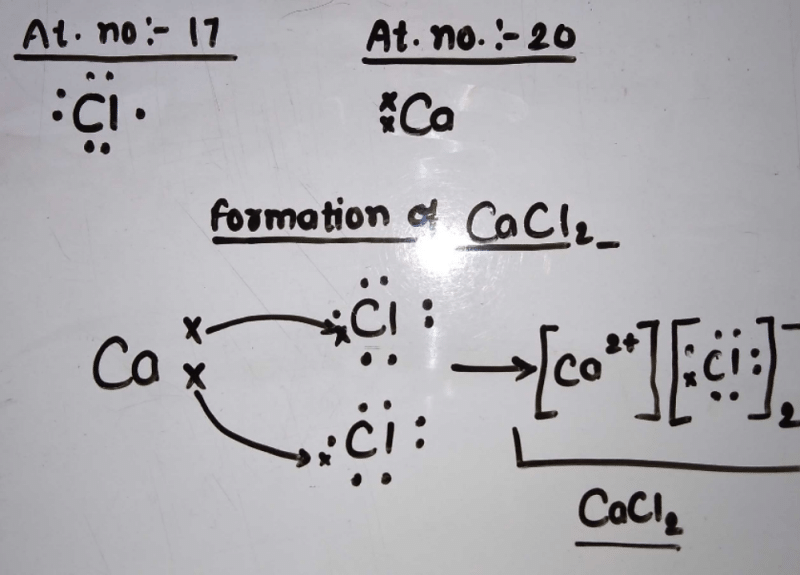Class 10 Exam > Class 10 Questions > Write electron dot structure for chlorine (At...
Start Learning for Free
Write electron dot structure for chlorine (At No. 7) and Calcium (At No.20) Show formation of Calcium Chloride by transfer of electrons.?
Most Upvoted Answer
Write electron dot structure for chlorine (At No. 7) and Calcium (At N...

Community Answer
Write electron dot structure for chlorine (At No. 7) and Calcium (At N...
Electron Dot Structure for Chlorine and Calcium
Chlorine: Chlorine has 7 electrons in its outermost shell. Its electron dot structure is:
Cl: • • • • • • •
Calcium: Calcium has 20 electrons in its outermost shell. Its electron dot structure is:
Ca: • • • • • • • • • • • • • • • •
Formation of Calcium Chloride by Transfer of Electrons
Calcium Chloride is formed by the transfer of electrons from Calcium to Chlorine.
Step 1: Calcium donates two electrons to Chlorine
Ca: • • • • • • • • • • • • • • • • • --> Ca2+ + 2e-
Cl: • • • • • • • + 2e- --> Cl-
Step 2: Chlorine accepts two electrons from Calcium
Ca2+ + 2e- --> Ca: • • • • • • • • • • • • • • • •
Cl- + 2e- --> Cl: • • • • • • •
Step 3: Calcium and Chlorine ions combine to form Calcium Chloride
Ca: • • • • • • • • • • • • • • • • • + Cl: • • • • • • • --> CaCl2
The resulting compound, Calcium Chloride, has a lattice structure and is held together by ionic bonds.
Explanation
In the electron dot structure of Calcium, there are two electrons in the outermost shell that are available for bonding. In the electron dot structure of Chlorine, there is only one electron in the outermost shell that is available for bonding. In order to achieve a stable electron configuration, Calcium donates two electrons to Chlorine, forming Ca2+ and Cl- ions. The resulting ions are attracted to each other by electrostatic forces, forming an ionic bond and resulting in the formation of Calcium Chloride. Calcium Chloride has many uses, including as a desiccant, de-icer, and food additive.
Attention Class 10 Students!
To make sure you are not studying endlessly, EduRev has designed Class 10 study material, with Structured Courses, Videos, & Test Series. Plus get personalized analysis, doubt solving and improvement plans to achieve a great score in Class 10.

|
Explore Courses for Class 10 exam
|

|
Similar Class 10 Doubts
Write electron dot structure for chlorine (At No. 7) and Calcium (At No.20) Show formation of Calcium Chloride by transfer of electrons.?
Question Description
Write electron dot structure for chlorine (At No. 7) and Calcium (At No.20) Show formation of Calcium Chloride by transfer of electrons.? for Class 10 2024 is part of Class 10 preparation. The Question and answers have been prepared according to the Class 10 exam syllabus. Information about Write electron dot structure for chlorine (At No. 7) and Calcium (At No.20) Show formation of Calcium Chloride by transfer of electrons.? covers all topics & solutions for Class 10 2024 Exam. Find important definitions, questions, meanings, examples, exercises and tests below for Write electron dot structure for chlorine (At No. 7) and Calcium (At No.20) Show formation of Calcium Chloride by transfer of electrons.?.
Write electron dot structure for chlorine (At No. 7) and Calcium (At No.20) Show formation of Calcium Chloride by transfer of electrons.? for Class 10 2024 is part of Class 10 preparation. The Question and answers have been prepared according to the Class 10 exam syllabus. Information about Write electron dot structure for chlorine (At No. 7) and Calcium (At No.20) Show formation of Calcium Chloride by transfer of electrons.? covers all topics & solutions for Class 10 2024 Exam. Find important definitions, questions, meanings, examples, exercises and tests below for Write electron dot structure for chlorine (At No. 7) and Calcium (At No.20) Show formation of Calcium Chloride by transfer of electrons.?.
Solutions for Write electron dot structure for chlorine (At No. 7) and Calcium (At No.20) Show formation of Calcium Chloride by transfer of electrons.? in English & in Hindi are available as part of our courses for Class 10.
Download more important topics, notes, lectures and mock test series for Class 10 Exam by signing up for free.
Here you can find the meaning of Write electron dot structure for chlorine (At No. 7) and Calcium (At No.20) Show formation of Calcium Chloride by transfer of electrons.? defined & explained in the simplest way possible. Besides giving the explanation of
Write electron dot structure for chlorine (At No. 7) and Calcium (At No.20) Show formation of Calcium Chloride by transfer of electrons.?, a detailed solution for Write electron dot structure for chlorine (At No. 7) and Calcium (At No.20) Show formation of Calcium Chloride by transfer of electrons.? has been provided alongside types of Write electron dot structure for chlorine (At No. 7) and Calcium (At No.20) Show formation of Calcium Chloride by transfer of electrons.? theory, EduRev gives you an
ample number of questions to practice Write electron dot structure for chlorine (At No. 7) and Calcium (At No.20) Show formation of Calcium Chloride by transfer of electrons.? tests, examples and also practice Class 10 tests.

|
Explore Courses for Class 10 exam
|

|
Suggested Free Tests
Signup for Free!
Signup to see your scores go up within 7 days! Learn & Practice with 1000+ FREE Notes, Videos & Tests.

























